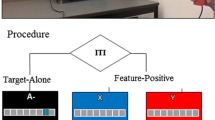Abstract
The effects of presenting a brief visual stimulus followed by response-independent delivery of food to rats were studied in four experiments. Both sign tracking, operation of a response key (Experiment 1) or a lever (Experiments 2, 3, and 4), and goal tracking, operation of a food tray flap, were obtained. Lower rates of both types of response occurred when the visual stimulus was unrelated to food delivery.
Possible influences of similarity between the visual stimulus and events accompanying food delivery were investigated by varying the visual stimulus and tray light conditions. Such an influence was detected only in a control condition when the stimulus was uncorrelated with food delivery. Various omission contingencies produced marked reductions in the target behavior.
Similar content being viewed by others
References
ATNIP, G. W. 1977. Stimulus- and response- reinforcer contingencies in autoshaping, operant, classical, and omission training procedures in rats. Journal of the Experimental Analysis of Behavior, 28, 59–69.
BOAKES, R. A. 1977. Performance on learning to associate a stimulus with positive reinforcement. In H. Davis & H. M. B. Hurwitz (Eds.), Operant-Pavlovian interactions. Hillsdale, N.J.: Lawrence Erlbaum Associates, Pp. 67–97.
BROWN, P. L., & JENKINS, H. M. 1968. Autoshaping ofjhe pigeon’s key peck. Journal of the Experimental A nalysis of Behavior, 11, 1–8.
DAVOL, G. H., STEINHAUER, G. D., & LEE, A. 1977. The role of preliminary magazine training in acquisition of the autoshaped key peck. Journal of the Experimental Analysis of Behavior, 28, 99–106.
GAMZU, E., & WILLIAMS, D. R. 1971. Classical conditioning of a complex skeletal act. Science, 171, 923–925.
HEARST, E. In press. Classical conditioning as the formation of interstimulus associations: Stimulus substitution, parasitic reinforcement and autoshaping. In A. Dickinson & R. A. Boakes (Eds.), Mechanisms of learning and motivation: A memorial volume to Jerzy Konorski. Hillsdale, N.J.: Lawrence Erlbaum Associates.
HEARST, E., & JENKINS, H. M. 1974. Sign-tracking: The stimulus-reinforcer relation and directed action. Austin, Texas: The Psychonomic Society.
JENKINS, H. M. & MOORE, B. R. 1973. The form of the autoshaped response with food and water reinforcers. Journal of the Experimental Analysis of Behavior, 20, 163–182.
LOCURTO, C., TERRACE, H. S., & GIBBON, J. 1976. Autoshaping, random control, and omission training in the rat. Journal of the Experimental Analysis of Behavior, 26, 451–462.
MILLENSON, J. R. 1975. System developments in the Act language: Towards machine independence. Behavior Research Methods and Instrumentation, 7, 165–173.
NEWLIN, R. J., & LOLORDO, V. M. 1976. A comparison of pecking generated by serial, delay, and trace autoshaping procedures. Journal of the Experimental Analysis of Behavior, 25, 227–241.
PETERSON, G. B., ACKIL, J. E., FROMMER, G. P., & HEARST, E. 1972. Conditioned approach and contact behavior towards signals for food or brain-stimulation reinforcement. Science, 177, 1009–1011.
RICCI, J. A. 1973. Key pecking under response-independent food presentation after long simple and compound stimuli. Journal of the Experimental Analysis of Behavior, 19, 509–516.
SCHWARTZ, B., & GAMZU, E. 1977. Pavlovian control of operant behavior: An analysis autoshaping and its implications for operant conditioning. In W. K. Honig & J. E. R. Staddon (Eds.), Handbook of operant behavior. Englewood Cliffs, N.J.: Prentice-Hall.
SCHWARTZ, B., & WILLIAMS, D. R. 1972. The role of the response reinforcer contingency in negative automaintenance. Journal of the Experimental Analysis of Behavior, 17, 351–357.
SKINNER, B. F. 1948. “Superstition” in the pigeon. Journal of Experimental Psychology, 38, 168–172.
STIERS, M., & SILBERBERG, A. 1974. Lever-contact responses in rats: Automaintenance with and without a negative response-reinforcer dependency. Journal of the Experimental Analysis of Behavior, 22, 497–506.
TIMBERLAKE, W., & GRANT, D. L. 1975. Autoshaping inrats to the presentation of another rat predicting food. Science, 190, 690–692.
WASSERMAN, E. A. 1973. Pavlovian conditioning with heat reinforcement produces stimulus-directed pecking in chicks. Science, 181, 511–520.
WILLIAMS, D. R., & WILLIAMS, H. 1969. Automaintenance in the pigeon: Sustained pecking despite contingent nonreinforcement. Journal of the Experimental Analysis of Behavior, 12, 511–526.
WOODRUFF, G., & WILLIAMS, D. R. 1976. The associative relation underlying autoshaping in the pigeon. Journal of the Experimental Analysis of Behavior, 26, 1–13.
Author information
Authors and Affiliations
Additional information
This research was conducted while the first and fourth authors were holders of UK Medical Research Council Research Studentships. Experiments 1 and 2 were included in a doctoral dissertation submitted to the University of Oxford by the first author.
Rights and permissions
About this article
Cite this article
Leslie, J.C., Boakes, R.A., Linaza, J. et al. Autoshaping Using Visual Stimuli in the Rat. Psychol Rec 29, 523–546 (1979). https://doi.org/10.1007/BF03394641
Published:
Issue Date:
DOI: https://doi.org/10.1007/BF03394641




